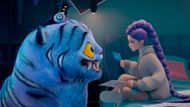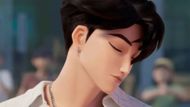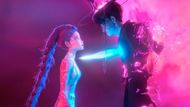K-Pop Demon Hunters creates a universe where electric digital animation meets old Korean symbolism in unexpected ways. The film introduces Jinu, the magnetic leader of the Saja Boys, a rival boy band shaped by demonic power.
The demon pets belong to Jinu. They move around him like living shadows, carrying fragments of his charisma and inner chaos. These creatures feel alive, echoing his tension between dominance and vulnerability.
Their presence also links them to Rumi, a hybrid born from a human and a demon. Rumi stands on the edge of two worlds, and the pets seem drawn to her silent struggle. This attraction creates a mysterious bond between her and Jinu, two characters who share a fractured identity and an unspoken understanding.
The design of these pets draws from minhwa, especially the Tiger and Magpie painting. Each creature holds the spirit of protection, hidden desire, and restless transformation. They serve as living reflections of Jinu’s emotional layers and Rumi’s hybrid nature, forming a spiritual bridge that pulls their worlds closer.
The tiger and magpie as foundational symbols
Tiger and Magpie (까치와 호랑이) paintings hold a mix of tension and humor that feels timeless. The tiger, or kkachi horangi, stares out with exaggerated features, blending raw energy and curiosity. Above, the magpie rests with calm precision, carrying messages of change and moments of luck. This combination suggests that wild strength and sharp awareness must move together to create balance.
In K-Pop Demon Hunters, Jinu’s demon pets channel this layered symbolism into their forms. The tiger-inspired shapes carry the spirit of fierce protection and the thrill of chaos, mirroring Jinu’s charismatic but unpredictable nature. The magpie elements bring watchfulness and an almost playful curiosity, hinting at Jinu’s hidden doubts and moments of softness under his powerful exterior.
These pets gravitate toward Rumi, pulled by her hybrid bloodline and her quiet search for identity. Their movements suggest recognition of her inner split and her need for belonging. Through them, Rumi and Jinu share a silent language, one built on shared glances and instinctive understanding rather than words.
The design details echo minhwa art deeply. Each curve and color choice feels rooted in old ink traditions, whispering of forest spirits and protective household charms. In these pets, the film reimagines ancestral guardians as living companions, merging mythical power with fragile emotional truth.

Ancestral imagery turned narrative companions
In minhwa, animals hold meanings that go beyond decoration. The tiger stands for raw instinct and unstoppable force, a spirit that refuses limits. The magpie moves between realms as a quiet messenger, carrying secrets and unexpected hope.
By turning these symbols into Jinu’s demon pets, K-Pop Demon Hunters builds a unique emotional structure. The pets become more than tools of intimidation or power; they act as mirrors for Jinu’s inner struggles and desires. Each movement and glance reveals pieces of his personality, from his sharp control to his hidden fears.

Their approach to Rumi deepens this symbolism. Drawn to her hybrid nature, they sense her silent pain and her search for place and meaning. Through these creatures, Jinu and Rumi develop a layered connection. The pets become bridges between their isolated worlds, creating shared moments of recognition and unspoken understanding.
These creatures move as extensions of Jinu’s spirit, echoing old beliefs that animals hold pieces of the soul. The film allows them to express longing and conflict without words, weaving gestures and stillness into an emotional map. Each pet comforts and challenges, pushing both Jinu and Rumi to confront parts of themselves they might wish to hide.
Through these bonds, the pets transform scenes into quiet rituals of revelation. Victories become small steps toward self-acceptance, and every encounter carries the weight of ancient stories retold in glowing, modern form.

Living symbols beyond decoration
Old minhwa paintings like Tiger and Magpie once watched over doorways and living spaces, holding silent power as protectors. In K-Pop Demon Hunters, this protective force reappears through Jinu’s demon pets, now alive and moving across neon-lit stages and city shadows.
Each pet carries inherited strength into modern conflict, merging spiritual folklore with futuristic animation. Their shifting forms, glowing eyes, and sudden bursts of energy echo ancient rituals and midnight prayers for safety. When a pet moves forward, it feels like a spirit stepping out of a forgotten shrine, bringing whispers of old forest winds and temple chants.
Their silent connection to Rumi adds another layer to K-Pop Demon Hunters. The pets react to her as if sensing a hidden piece of themselves inside her. This fragile, magnetic pull transforms them from simple weapons into emotional companions. Even in chaos, they hint at warmth and shared recognition, balancing the darkness in Jinu’s presence.
Choosing to make these creatures vessels of old symbols turns battles into ceremonial acts. Each clash and pause invites viewers to look beyond the surface and feel the memory inside each movement. The pets speak through looks and breath, guiding stories that mix longing and power.
In every small motion, they expand the film’s world into something deeper, letting each fight echo with ancestral protection and unseen kindness.
A cultural dialogue in motion
Every pet in K-Pop Demon Hunters carries a silent story woven through movement and presence. A creature standing close to Jinu shows his heavy pride and hidden tenderness. Another that circles near Rumi reveals her hesitation and her need for connection beyond her hybrid identity.
These pairings shape each encounter into a kind of shared pilgrimage, where strength and vulnerability walk side by side. The pets move as storytellers, never overshadowing but always illuminating the emotional paths of Jinu and Rumi. Each glance or soft approach adds new weight to the narrative, creating layers that deepen with every scene.
K-Pop Demon Hunters transforms these creatures into living echoes of collective memory, uniting past and present in a single breath. Minhwa, once seen on quiet walls and scrolls, becomes alive in a glowing, futuristic world. The pets step forward as protectors and mirrors, reminding the audience that tradition changes shape but keeps its soul.
When they leap into conflict or watch silently from the edge of a stage, they carry echoes of mountain winds, flickering lanterns, and ancestors' quiet watch. They invite viewers into emotional spaces rarely touched by fast action, encouraging slow reflection even within high-speed battles.
Through these moments of K-Pop Demon Hunters, the pets become bridges, inviting every viewer to sense the old stories pulsing beneath every sharp line and luminous eye.
K-Pop Demon Hunters and the enduring spirit of the kkachi horangi
As K-Pop Demon Hunters progresses, Jinu’s pets deepen their roles, stepping forward as guardians of emotion and spirit. Their eyes suggest a lineage of protectors who once stood by farmers and travelers under moonlit skies. Each silent glance carries old wisdom, echoing watchful ancestors who offered strength in quiet moments.
During the battles in K-Pop Demon Hunters, these pets embody survival, standing firm without hesitation. In softer scenes, they transform into protectors of fragile hopes, holding Rumi’s inner conflicts in an invisible embrace. The kkachi horangi spirit does not rest as decoration; it lives and breathes, shaping every step and choice.
K-Pop Demon Hunters carries this legacy into bright lights and sharp edits, yet under every visual shock beats the calm pulse of cultural memory. Each pet becomes a walking reminder that true strength grows from care and shared understanding.
Through them, the film offers a gentle invitation to honor old beliefs in new struggles. In each sudden leap or soft pause, they whisper of futures carried by ancestral courage, turning every frame into a promise of protection and quiet renewal that stretches far beyond the screen.
Love movies? Try our Box Office Game and Movie Grid Game to test your film knowledge and have some fun!
